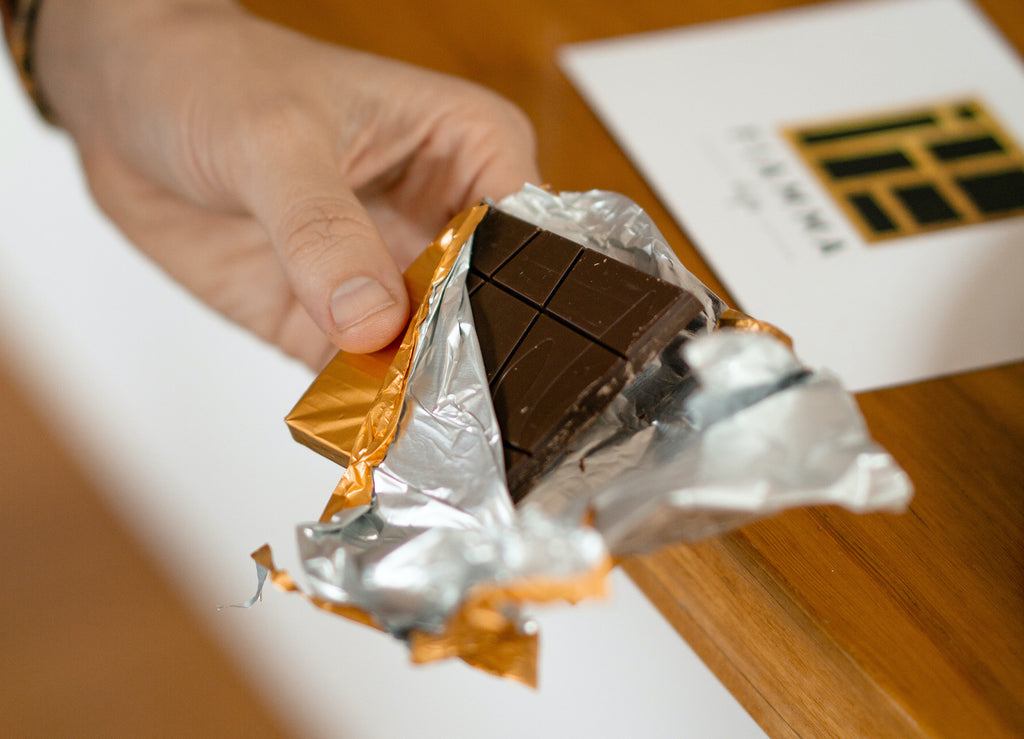You’ve probably seen the term ‘single origin’ on some chocolate wrappers, but what does it actually mean? The answer is surprisingly complex…
Just like specialty coffee, when we talk about a chocolate’s ‘origin’, we’re talking about the place where the cacao beans were grown. However, there’s a broad range of possible meanings within the term - it could mean that the beans come from one country, one region, one neighbourhood, one farm, or even one specific tree!
The most common scenario is that single origin bars use cacao from one particular region, where beans are collected from hundreds - or even thousands of farms. The problem with this is, the wider the variety of beans you use, the less specific the flavour profile; it’s the equivalent of a wine coming from the Mornington Peninsula, where a random mix of grapes - different varieties and different flavour profiles - are blended together.
Working on a smaller, more specific scale can be logistically challenging and very expensive, but some craft chocolate makers do this and create exceptional single plantation/estate bars, such as the Akesson’s Pink Pepper bar or the Michel Cluizel Mangaro 71% bar.
Why does it matter?
A big part of the attraction to single origin chocolate is terroir. Just like wine, specific farms or farming regions have a reputation for producing exceptional cacao. This is due to a range of factors, including the genetics of the cacao in that area, climate, soil, geography, and farming practices. In the 1990s, companies like Valrhona in France and Amedei in Italy started bringing the concept of terroir into the chocolate market.
Due to a lot of clever marketing and some dubious packaging design, there’s a common misconception that single origin chocolate is always high quality. That is definitely not the case - these days there are many single origin bars that are mass-produced with low quality cacao, and likewise there are exceptional bars made with blends of beans from all corners of the globe. Some origins of cacao correctly have a great reputation, but whether a bar is single origin or not tells you nothing about quality. In addition, great beans don’t make great chocolate alone - it also depends on the skill of the chocolate maker.
There are also misconceptions that certain origins always taste a particular way - such as Peruvian cacao is always fruity or Papua New Guinea cacao is always smokey. These beliefs usually stem from certain bean suppliers dominating the market and working with a lot of chocolate makers around the world, resulting in many different bars of the same origin having a similar flavour. But the reality is that most cacao-growing countries have a big mixture of genetics, terroir and farming practices, and a huge range of flavours can be found in each country.

Great single origin chocolate
When done well, single origin chocolate can be a pure representation of place, and each bite can offer a mini holiday for your taste buds. We never cease to be amazed by the incredible variety of flavours that our favourite chocolate makers find in different types of beans. Here are some of the best single origin bars we currently have in stock…
Cuvée Chocolate - Amphora 65% (Peru)
This sweet and fruity bar from Cuvée Chocolate is a great introduction to single origin dark chocolate. The notes of cherry and tropical fruit will amaze people who are new to craft chocolate. Notice how the flavours develop as the chocolate melts - we call this the ‘flavour journey’.
Foundry Chocolate - Karkar Island, Papua New Guinea 70%
Probably the best PNG bar you’ll ever taste. Many people think that PNG beans are inherently smokey, but that’s usually because they’ve been fire-dried instead of sun-dried (that’s another blog post). The incredible notes of lychee and pawpaw in this bar will change your perception of what chocolate can be.
When you add milk to chocolate you lose a little of the unique cacao flavour, but single origin milk chocolate can still blow your mind. This bar from Omnom is an exceptional example, with just enough cacao to still taste the unique cherry and nutty notes, and the perfect fudgey flavour from the milk to balance everything to perfection.
Pump Street - Ambanja, Madagascar 72%
Cacao from Bertil Akesson’s estate in Northern Madagascar is renowned for its bright citrus flavours, and this is a classic example. It’s a long way from the traditional ‘chocolatey’ flavour that we all grew up with, but it still has satisfying deep notes to balance out the fruitiness.
Soma Chocolate - Vanua, Fiji Milk 55%
This bar is made with Amelonado cacao, which usually offers a more traditional chocolatey flavour. When master chocolate makers like Soma get their hands on these beans, the result is a ludicrously rich and comforting bar, with notes of caramel, malt and honey. It’s accessible without being basic, and a perfect bar to convert people who are new to craft chocolate.
Valrhona - Manjari, Madagascar 64%
The most popular bar in Valrhona’s range and probably the first ever bar that was labelled ‘single origin’. The notorious Madagascan fruitiness is there but the lower cacao content and deeper roast makes it less intense than the Pump Street bar. This bar is a classic for a reason!
If you haven’t yet discovered the joys of single origin chocolate, what are you waiting for?! Order a few different origins today and take your tastebuds on a round the world trip!
